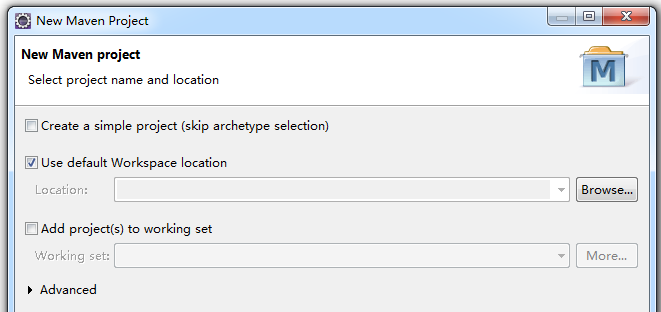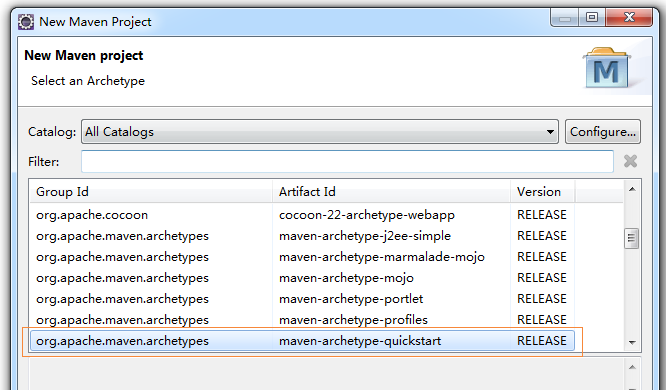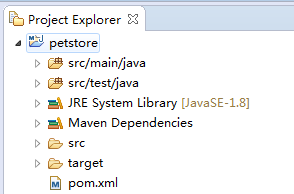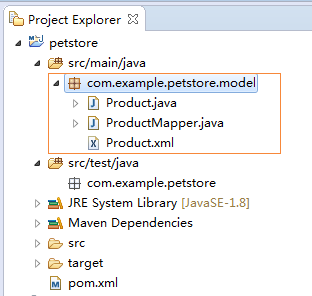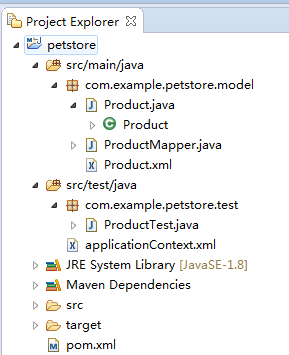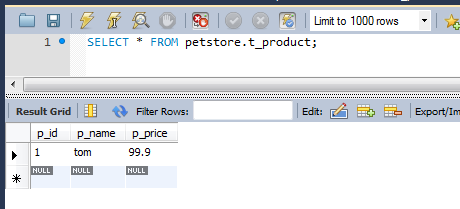從頭開始基於Maven搭建SpringMVC+Mybatis專案(1)
技術發展日新月異,許多曾經擁有霸主地位的流行技術短短几年間已被新興技術所取代。
在Java的世界中,框架之爭可能比語言本身的改變更讓人關注。近幾年,SpringMVC憑藉簡單輕便、開發效率高、與Spring框架無縫整合等特點,逐漸擊敗前輩Struts/Struts2,成為最常用的Web框架。而Mybatis相對於Hibernate,同樣具有開發簡單、效率高的優勢,而且對SQL的可控性更好,有利於效能調優,逐漸也積累了挑戰Hibernate的實力和人氣。
當前SpringMVC+Mybatis已經成為最流行的框架組合之一。
好的框架可以幫我們簡化開發,但實際的工作中還有大量的時間是花在編譯、測試、打包、部署等構建工作上,即使IDE變得越來越強大,但這些工作仍然需要我們一步一步去操作,而不能變成自動化的流水線作業。每天、每個專案重複這些步驟是毫無意義的,所以我們需要構建工具的幫助。構建工具的可選擇性並不是很多,Maven是目前是主流的選擇,它可以幫助開發者自動化構建、標準化結構、管理依賴等,極大的提高程式碼以外的工作效率。
Maven、SpringMVC、Mybatis的組合優雅而強大,但對於初學者來說,把三者整合在一起並不是一件簡單的事。本文對這一複雜過程做拆解,從最基礎的步驟開始,一步步搭建起一個支援增、刪、改、分頁查詢的Web專案。
本文以Eclipse為開發工具,並需要安裝好Maven及Maven Integration for Eclipse外掛,資料庫使用MySQL。
如果沒有安裝過Maven可以參考:
下面正式開始。
開啟Eclipse,依次點選 File -> New -> Maven Project
這一步不做任何修改,直接下一步
接下來是選擇Archetype。Maven提倡約定優於配置,對於原始碼目錄結構、配置檔案位置、測試使用者目錄等內容都有既定的規則。遵循這些規則的好處就是不同開發者建立的專案結構是一致的,減少了在加入新專案時額外的熟悉和學習成本。
Maven內建的多種archetype可以針對不同型別的專案幫助開發者迅速勾勒出專案的骨架,例如Web專案可以選擇maven-archetype-webapp,自動建立的目錄中包括webapp等。這裡從最基礎的開始,選擇maven-archetype-quickstart,其他選項保持不變,點選下一步。
這一步中填寫專案的基本資訊。Group Id和Artifact Id用於標註專案或模組的座標,Maven的一大功能是管理依賴(jar包),Maven的中央倉庫中有成千上萬的的開源專案,在倉庫中找到所需的專案檔案就需要給每個專案分配一個唯一的標識。Group Id用於定義當前的專案,每個專案下按功能可能劃分多個模組,Artifact Id定義具體的模組。例如Spring專案的Group Id是org.springframework,其下面劃分了Artifact Id為spring-core、spring-context、spring-jdbc等多個模組。
輸入Group Id和Artifact Id後點擊完成。完成後生成的專案結構如下:
預設生成了src/main和src/test兩個資料夾,根據約定,main放置專案原始碼,test目錄放置測試用例。預設還生成了兩個演示檔案(App.java和AppTest.java)可以直接刪除。
本例中我們使用Mybatis操作MySQL資料庫,並使用Spring整合,這些都需要新增依賴,即jar包。藉助Maven,開發者不再需要去各個網站下載檔案,而只需要配置pom.xml即可。開啟pom.xml,預設程式碼如下:
<project xmlns="http://maven.apache.org/POM/4.0.0" xmlns:xsi="http://www.w3.org/2001/XMLSchema-instance"
xsi:schemaLocation="http://maven.apache.org/POM/4.0.0 http://maven.apache.org/xsd/maven-4.0.0.xsd">
<modelVersion>4.0.0</modelVersion>
<groupId>com.example</groupId>
<artifactId>petstore</artifactId>
<version>0.0.1-SNAPSHOT</version>
<packaging>jar</packaging>
<name>petstore</name>
<url>http://maven.apache.org</url>
<properties>
<project.build.sourceEncoding>UTF-8</project.build.sourceEncoding>
</properties>
<dependencies>
<dependency>
<groupId>junit</groupId>
<artifactId>junit</artifactId>
<version>3.8.1</version>
<scope>test</scope>
</dependency>
</dependencies>
</project>...
<properties>
<project.build.sourceEncoding>UTF-8</project.build.sourceEncoding>
<springframework.version>4.2.6.RELEASE</springframework.version>
</properties>
<dependencies>
<dependency>
<groupId>junit</groupId>
<artifactId>junit</artifactId>
<version>4.12</version>
<scope>test</scope>
</dependency>
<dependency>
<groupId>org.springframework</groupId>
<artifactId>spring-test</artifactId>
<version>${springframework.version}</version>
<scope>test</scope>
</dependency>
<dependency>
<groupId>org.springframework</groupId>
<artifactId>spring-core</artifactId>
<version>${springframework.version}</version>
</dependency>
<dependency>
<groupId>org.springframework</groupId>
<artifactId>spring-context</artifactId>
<version>${springframework.version}</version>
</dependency>
<dependency>
<groupId>org.springframework</groupId>
<artifactId>spring-beans</artifactId>
<version>${springframework.version}</version>
</dependency>
<dependency>
<groupId>org.springframework</groupId>
<artifactId>spring-jdbc</artifactId>
<version>${springframework.version}</version>
</dependency>
<dependency>
<groupId>c3p0</groupId>
<artifactId>c3p0</artifactId>
<version>0.9.1.2</version>
</dependency>
<dependency>
<groupId>org.mybatis</groupId>
<artifactId>mybatis</artifactId>
<version>3.4.1</version>
</dependency>
<dependency>
<groupId>org.mybatis</groupId>
<artifactId>mybatis-spring</artifactId>
<version>1.3.0</version>
</dependency>
<dependency>
<groupId>mysql</groupId>
<artifactId>mysql-connector-java</artifactId>
<version>5.1.18</version>
</dependency>
</dependencies>
</project>注意這裡使用了一個小技巧,spring有多個模組且使用相同的版本號,所以設定了一個<springframework.version>屬性常量,如果需要修改版本只需要修改此處常量值即可。
至此Maven配置完成,下面開始Mybatis部分。
本例中要實現的功能很簡單,基於關係型資料庫對某種商品做插入和查詢的管理,商品僅有名稱和價格兩個屬性。首先準備好資料庫。
建庫:
CREATE SCHEMA `petstore` DEFAULT CHARACTER SET utf8 COLLATE utf8_bin ;CREATE TABLE `petstore`.`t_product` (
`p_id` INT NOT NULL AUTO_INCREMENT,
`p_name` VARCHAR(45) NOT NULL,
`p_price` FLOAT NOT NULL,
PRIMARY KEY (`p_id`))
ENGINE = InnoDB
DEFAULT CHARACTER SET = utf8;Product.java - 對映實體類
ProductMapper.java - 介面,定義可呼叫的方法
Product.xml - 實際執行的SQL對映檔案
新增程式碼檔案後的目錄結構如下:
三個檔案的程式碼如下:
Product.java
package com.example.petstore.model;
public class Product {
private int id;
private String name;
private float price;
public int getId() {
return id;
}
public void setId(int id) {
this.id = id;
}
public String getName() {
return name;
}
public void setName(String name) {
this.name = name;
}
public float getPrice() {
return price;
}
public void setPrice(float price) {
this.price = price;
}
}package com.example.petstore.model;
public interface ProductMapper {
void addProduct(Product product);
Product selectById(int id);
}
<?xml version="1.0" encoding="UTF-8"?>
<!DOCTYPE mapper PUBLIC "-//mybatis.org//DTD Mapper 3.0//EN" "http://mybatis.org/dtd/mybatis-3-mapper.dtd">
<mapper namespace="com.example.petstore.model.ProductMapper">
<resultMap type="com.example.petstore.model.Product" id="productMap">
<id column="p_id" property="id" />
<result column="p_name" property="name" />
<result column="p_price" property="price" />
</resultMap>
<insert id="addProduct" parameterType="com.example.petstore.model.Product" useGeneratedKeys="true" keyProperty="id">
insert into t_product(p_name,p_price) values(#{name},#{price})
</insert>
<select id="selectById" parameterType="int" resultType="com.example.petstore.model.Product" resultMap="productMap">
select * from t_product where p_id=#{id}
</select>
</mapper>程式碼中並沒有生成ProductMapper的實現類,而是在執行期間動態建立代理類來完成例項化。
到這裡Mybatis程式碼就開發完成了,但是我們還想知道這些程式碼是否可以正常工作,需要編寫一些測試用例。
如果僅使用Mybatis(而不使用Spring),那麼還要新增Mybatis配置檔案設定資料庫連線等,但這裡不打算這麼做,而是用Spring接管,所以接下來的程式碼是Spring核心配置檔案applicationContext.xml。注意這裡是用於測試,所以檔案將新增在src/test/java目錄。
applicationContext.xml
<?xml version="1.0" encoding="UTF-8"?>
<beans xmlns="http://www.springframework.org/schema/beans"
xmlns:xsi="http://www.w3.org/2001/XMLSchema-instance" xmlns:aop="http://www.springframework.org/schema/aop"
xmlns:tx="http://www.springframework.org/schema/tx" xmlns:jdbc="http://www.springframework.org/schema/jdbc"
xmlns:context="http://www.springframework.org/schema/context"
xsi:schemaLocation="
http://www.springframework.org/schema/context http://www.springframework.org/schema/context/spring-context-3.0.xsd
http://www.springframework.org/schema/beans http://www.springframework.org/schema/beans/spring-beans-3.0.xsd
http://www.springframework.org/schema/jdbc http://www.springframework.org/schema/jdbc/spring-jdbc-3.0.xsd
http://www.springframework.org/schema/tx http://www.springframework.org/schema/tx/spring-tx-3.0.xsd
http://www.springframework.org/schema/aop http://www.springframework.org/schema/aop/spring-aop-3.0.xsd">
<bean id="dataSource" class="com.mchange.v2.c3p0.ComboPooledDataSource"
destroy-method="close">
<property name="driverClass" value="com.mysql.jdbc.Driver" />
<property name="jdbcUrl" value="jdbc:mysql://localhost:3306/petstore?useUnicode=true&characterEncoding=UTF8" />
<property name="user" value="root" />
<property name="password" value="root123456" />
<property name="minPoolSize" value="2" />
<property name="maxPoolSize" value="10" />
</bean>
<bean id="sqlSessionFactory" class="org.mybatis.spring.SqlSessionFactoryBean">
<property name="dataSource" ref="dataSource" />
<property name="mapperLocations" value="classpath*:com/example/petstore/model/*.xml" />
</bean>
<bean class="org.mybatis.spring.mapper.MapperScannerConfigurer">
<property name="basePackage" value="com.example.petstore.model" />
</bean>
</beans>其中,資料庫的連線串及使用者名稱、密碼是我的測試機的設定,你需要按你的環境進行修改。
然後是測試用例,在src/test/java下新增類com.example.petstore.test.ProductTest.javapackage com.example.petstore.test;
import static org.junit.Assert.*;
import org.junit.Test;
import org.junit.runner.RunWith;
import org.springframework.beans.factory.annotation.Autowired;
import org.springframework.test.context.ContextConfiguration;
import org.springframework.test.context.junit4.SpringJUnit4ClassRunner;
import com.example.petstore.model.Product;
import com.example.petstore.model.ProductMapper;
@RunWith(SpringJUnit4ClassRunner.class)
@ContextConfiguration(locations = "classpath:applicationContext.xml")
public class ProductTest {
@Autowired
private ProductMapper productMapper;
@Test
public void insertAndSelect() {
Product product1 = new Product();
product1.setName("tom");
product1.setPrice(99.9f);
productMapper.addProduct(product1);
assertTrue(product1.getId() > 0);
Product product2 = productMapper.selectById(product1.getId());
assertTrue(product2.getId() == product1.getId());
assertTrue(product2.getName().equals(product1.getName()));
}
}執行一下看看,在ProductTest.java上點右鍵 -> Run As -> Junit Test
測試通過,來看一下資料庫裡的內容:
總結
上述示例中完成了通過Maven建立簡單專案、對資料庫表的插入和讀取操作,儘管沒什麼實用性,但也能夠了解到了Mybatis的基本用法及與Spring的整合方式。
專案以jar包形式打包釋出,這樣做有利於程式碼複用,但是顯然無法再增加Web部分的內容。傳統的做法是另建一個Web專案並引用此專案,但我們接下來將使用Maven的聚合和繼承功能構建包括一個數據庫持久層模組和一個基於SpringMVC的Web模組的聚合專案,這些內容在下一節中介紹。

